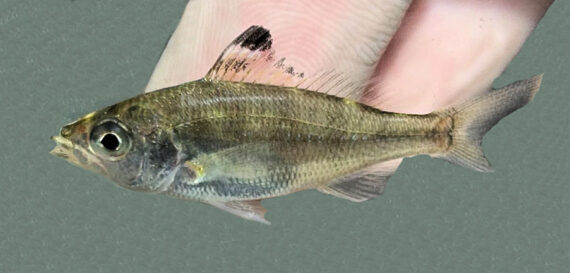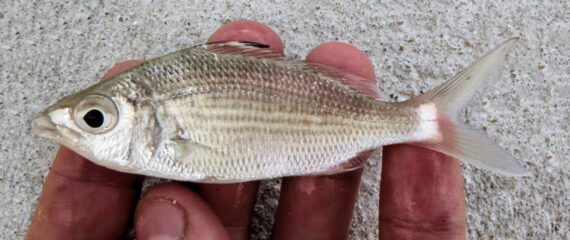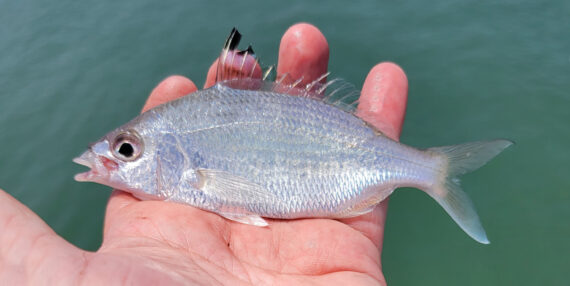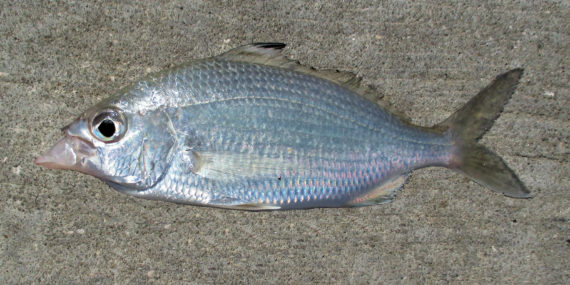Flagfin Mojarra, Eucinostomus melanopterus
 Flagfin Mojarra, Eucinostomus melanopterus, Juvenile. Fish caught from coastal waters off Long Island, New York, September 2023. Length: 9.1 cm (3.6 inches). Catch, photograph, and identification courtesy of Aidan Perkins, Long Island, New York.
Flagfin Mojarra, Eucinostomus melanopterus, Juvenile. Fish caught from coastal waters off Long Island, New York, September 2023. Length: 9.1 cm (3.6 inches). Catch, photograph, and identification courtesy of Aidan Perkins, Long Island, New York.
 Flagfin Mojarra, Eucinostomus melanopterus. Fish caught from coastal waters off Belize, July 2015. Length: 12 cm (4.7 inches). Catch, photograph, and identification courtesy of Josh Leisen (joshadventures.com), Gaylord, Michigan.
Flagfin Mojarra, Eucinostomus melanopterus. Fish caught from coastal waters off Belize, July 2015. Length: 12 cm (4.7 inches). Catch, photograph, and identification courtesy of Josh Leisen (joshadventures.com), Gaylord, Michigan.
 Flagfin Mojarra, Eucinostomus melanopterus. Fish caught off Fisherman’s Pier, Port Canaveral, Florida, June 2023. Length: 13 cm (5.1 inches). Catch, photograph, and identification courtesy of Chris Moore, Peoria, Arizona.
Flagfin Mojarra, Eucinostomus melanopterus. Fish caught off Fisherman’s Pier, Port Canaveral, Florida, June 2023. Length: 13 cm (5.1 inches). Catch, photograph, and identification courtesy of Chris Moore, Peoria, Arizona.
 Flagfin Mojarra, Eucinostomus melanopterus. Fish caught off the Juno Beach Pier, West Palm Beach, Florida, February 2017. Length: 15.0 cm (5.9 inches). Catch and photograph courtesy of George Brinkman, Guelph, Ontario, Canada.
Flagfin Mojarra, Eucinostomus melanopterus. Fish caught off the Juno Beach Pier, West Palm Beach, Florida, February 2017. Length: 15.0 cm (5.9 inches). Catch and photograph courtesy of George Brinkman, Guelph, Ontario, Canada.
The Flagfin Mojarra, Eucinostomus melanopterus, is a member of the Mojarra or Gerreidae Family, and is known in Mexico as mojarra de ley. Globally, there are eleven species in the genus Eucinostomus, all found in Mexican waters, with seven in the Atlantic and four in the Pacific Ocean.
The Flagfin Mojarra has a moderately deep, fusiform, and compressed body with a depth that is 34% to 38% of standard length. They are silvery white and the tip of their spiny dorsal fin has a wide black tip and a white band below, providing a key to identification. Their anal fins are pale yellow. Adults have no additional distinguishing marks. Juveniles have dark vertical bars on their back and sides. Their head has a concave lower profile, large eyes, and a pointed snout. Their mouth is highly extensible, pointing downward when protruded. They have smooth gill covers. Their anal fin has 3 slender spines, with the second spine being stronger and shorter than the third spine, and 7 or 8 rays; their caudal fin is deeply forked; their dorsal fin is elevated at the front and deeply notched and has 9 spines and 10 rays; and, their pectoral fins are long and reach the anal fin origin. They have 9 gill rakers on the lower arch. Their head and body are covered with rough scales. Their lateral line is slightly arched.
The Flagfin Mojarra is a schooling species found in shallow coastal areas over sandy and muddy bottoms, in lower coastal rivers, and in freshwater lagoons at depths up to 76 m (250 feet) and in water temperatures between 24oC (75oF) and 28oC (82oF). They reach a maximum of 30 cm (12 inches) in length. They are diadromous and migrate up to 30 miles between freshwater and oceanic waters on cyclical and predictable schedules. These migrations are not related to breeding. They are found mixed with Largescale Fat Snook, Centropomus mexicanus (which they mimic) and Spotfin Mojarra, Eucinostomus argenteus. They feed during the daytime in small continuous moving schools consuming detritus, small fish, mollusks, shrimp, and zooplankton. Reproduction is oviparous and occurs at sea. The Flagfin Mojarra is poorly studied with very limited information available about their lifestyle and behavioral patterns including specific details on age, growth, longevity, movement patterns, diet, habitat use, and reproduction.
The Flagfin Mojarra is a resident of all Mexican waters of the Atlantic Ocean including the Gulf of Mexico and the east coast of the Yucatán Peninsula in the Caribbean. There are documented large populations within the Laguna Madre and the mouth of the Río Soto La Marina in the State of Tamaulipas and within the lagoon of the Isla de Sacrificios in the State of Veracruz on a seasonal basis.
The Flagfin Mojarra is most likely confused with the Silver Jenny, Eucinostomus gula and the Spotfin Mojarra, Eucinostomus argenteus, but both lack the black-tipped dorsal fin. It is also very similar to the Pacific Flagfin Mojarra, Eucinostomus currani, which is a resident of the Pacific Ocean.
From a conservation perspective the Flagfin Mojarra is currently considered to be of Least Concern with stable, widely distributed populations. They are small in stature and of interest to most. In some areas they are caught with cast nets, beach seines, set nets, handlines, and bottom trawls where they are marketed fresh (but in low demand) or used as live bait.
NOTE. There are eighteen members of the Mojarra or Gerreidae Family currently Included in this website, ten are from Mexican waters of the Pacific and eight from the Atlantic. They are all very similar in appearance and difficult to identify. As an aide to this challenge I have assembled a Mojarra Body Depth Chart that presents these seventeen mojarras from thin bodied to deep bodied which is useful in identification work. In addition, I have also assembled a Mojarra Maximum Length Chart which I have also helpful in the identification work for these eighteen mojarras. Both charts can be found at the end of the Mojarra Family Page.